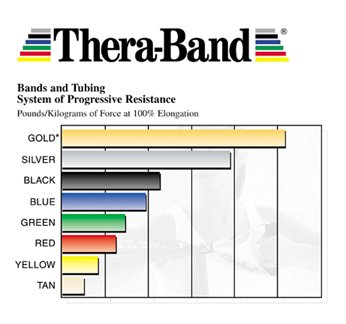A Guide to Buying and Using Therabands
Above is a demonstration on a shoulder routine done in a doctors office utilizing these therabands.
This has to be the most uncomplicated training aid on the market. Yet their versatility is staggering. In an industry littered with over priced gimmicks, they are a classic example that simplicity is often the most effective approach.
Used in rehab facilities around the world these bands are the only resistive exercise bands & tubing endorsed by the American Physical Therapy Association (APTA). As a hospital-based Exercise Physiologist I use Therbands everyday in cardiac rehab classes and with patients suffering with pulmonary disease. Their versatility and simplicity means they can be adapted to suit everyone -- from a young, fit 20 year old to a triple heart bypass patient in their twilight years.
For the uninitiated here's a quick explanation of what Therabands are and how they work...
They are basically heavy-duty rubber strips. They come in different colors that correspond to how thick the rubber is and how much resistance they provide. You buy them in rolls rather than individual bands. Different exercises require different lengths of Theraband so simply cut a few pieces (3-5 feet) off the roll and you're ready to go. If ever they snap you have an instant replacement.
If you're looking for a low-cost way to exercise at home Therabands are ideal. They will tone and strengthen your muscles without putting an undue amount of stress on your joints. You could set up a circuit of 10 exercises and do each one for 3 minutes (something we do in the cardiac rehab classes). It's an excellent way to raise your heart rate providing an aerobic element to your fitness training.
For Personal Trainers and class instructors, resistance bands are perfect. Because they are so lightweight and versatile they don't take up the space of more cumbersome exercise equipment.

Obviously there's no need to buy a roll of every color. To give you a frame of reference the yellow bands can be used by 70 and 80 year olds in our classes. Unless you are recovering from an injury, the yellow bands are too light for most people.
If you are out of shape and haven't exercised for long time I would start off with the red Therabands. Ideally you'd also by the green or blue because you'll find some exercises easier than others... and you want to have something to progress to.
If you exercise regularly and you're considering Therabands as an additional option for home workouts start with the green or blue. Although the blue is extra heavy it's not so strong that you need to be a bodybuilder to use it. Put it this way, after a 6week program most of our cardiac and pulmonary rehab patients are using the blue Therabands.
Picking a color does not need to be an exact science. You can vary the resistance by simply shortening the bands by wrapping them round your hands a few times or folding them in half.
A quick point about resistance... Therabands won't build rippling muscles. If you want to bulk up or build considerable strength you need to join a gym or buy a set of heavy dumbbells. Therabands are designed to tone and firm and build functional strength.
